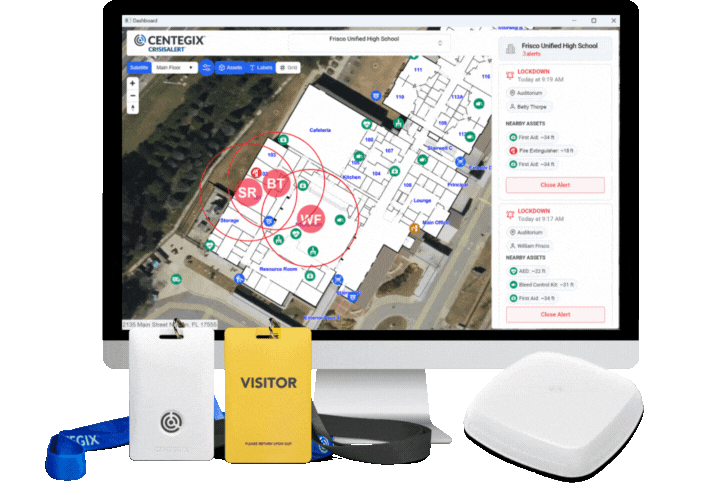Protecting your most vulnerable students, staff, and visitors is not only an essential responsibility but having a plan in place will give the rest of your staff a sense of safety and peace of mind. But even the best emergency response plan falls short if it doesn’t consider the safety of everyone.
The National Education Association (NEA) conducted a survey of the factors affecting teacher retention and found that “an alarming 55 percent of educators now indicate that they are ready to leave the profession they love earlier than planned.” The National Bureau of Labor Statistics reported 567,000 fewer teachers after the pandemic compared with before. At the same time, K-12 public school enrollment is projected to increase by nearly two percent in the next five years.
Would your district’s educators, staff, and students feel more empowered and better supported if you had a comprehensive and inclusive emergency response plan?
Having on-person safety badges, accessibility tools, and an inclusive emergency response plan helps teachers, students, and staff feel safer, leading to calmer and better emergency response.
Diversity, Equity, Inclusion, and Safety Are Factors Affecting Teacher Retention
Among those surveyed by the NEA, responses are even more stark amongst already underrepresented groups like black (62%) and Hispanic/Latinx (59%) teachers. Research increasingly shows that students have better outcomes when learning from teachers from diverse backgrounds. Students from minority populations have higher scores and fewer missed school days when they have at least one teacher from a minority group.
The need for a diverse teacher pool is clear. Attracting and retaining a diverse educator population goes beyond inclusive curriculum and classroom planning. Because safety concerns are one of the factors affecting teacher retention, especially as it pertains to educators from minority populations, a one-size-fits-all safety plan isn’t enough.
Plans created without considering the needs of people from different backgrounds often neglect teachers and students with non-majority backgrounds, languages, and accessibility needs.
An inclusive safety plan protects everyone in your school and signals to everyone that they are safe, valued, and included.
Student Outcomes
Students feel safer when plans are catered to them during crisis situations. And research shows again and again that students have better classroom outcomes when they feel safer. When students don’t feel safe, they can experience depression and anxiety and even engage in fighting.
According to the National Center for Education Statistics, “19 percent [of students] indicated that bullying had somewhat or a lot of negative effect on their school work and on their relationships with friends or family, and 14 percent indicated that bullying had somewhat or a lot of negative effect on their physical health.”
When teachers cut instructional time short to deal with emergencies, it also impacts student achievement. Having a response plan in place cuts down on instructional time loss and gives your students a better quality of education.
These statistics must also be considered from the standpoint of diversity, equity, and inclusion since minority groups are often the victims of bullying.
Take DEI into Consideration when Drafting Emergency Response Plans
Inclusivity doesn’t have to be another planning burden when you consider it an opportunity to broaden your pool of teachers and staff and attract students and families. Emergency response plans must account for everyone. Teachers deserve to feel safe and supported at work, and students deserve to feel safe while learning—no matter their background.
Those in your school who do not use English as their primary language should have access to emergency resources in their most comfortable language—including planning materials as well as emergency-in-progress resources and information.
Students and staff who use movement and ability tools like walking aids and wheelchairs must feel safe and empowered in their emergency response—the same for those with differing ability levels and needs.
The Safe and Sound Schools TEAMS Framework
Safe and Sound Schools, a nonprofit that supports increased safety efforts in public schools, provides schools with its TEAMS Framework. The framework can serve as a reminder of the diversity of needs your emergency response plan must consider.
- Transportation and mobility
- Emotional, mental, and behavioral health
- Auxiliary communication
- Medical health
- Security and supervision
Common Barriers
-
- Language – Your students, teachers, and staff may be most proficient in languages other than English. You must make emergency response plans available in their most comfortable language. Any resources used in an emergency response event should also be available in their language. Even for those who speak English, having access to their most proficient language can save valuable time in an emergency situation.
- Hearing – Most alert systems are auditory, making it impossible for people who are hard of hearing or with hearing loss to know what is going on. A plan that includes visual emergency cues is crucial for these members of your school community.
- Physical and mental abilities – Individuals with differing physical and mental abilities must also feel safe and empowered to take action during an emergency response situation. And the needs vary from person to person, so these plans cannot be one-size-fits-all.
How CrisisAlert™ Technology Can Be a Part of Your Inclusive Emergency Response Plan
CENTIGIX designed CrisisAlert™ technology for schools with a diversity of emergency response needs so you can keep your schools safe and make your teachers, students, and staff feel protected.
Customizable options for multiple languages
Customizing your emergency response tools for multiple languages is crucial in protecting a diverse teacher and student population.
CENTIGIX CrisisAlert™ Technology has desktop takeover tools and auditory emergency message systems that can be customized to feature multiple languages.
Multisensory Alerts
Your emergency response plans must account for the members of your community with varying levels of sensory perception. Flashing lights and physical indicators must accompany audible alarms.
CrisisAlert™ uses facility-wide multi-sensory alerts, including colored strobe lights, desktop alerts, and intercom integration.
Signal for Help with Limited Motor Skills
Choose a technology that offers on-person emergency triggers instead of stationary, on-location triggers. People who cannot easily move need to be able to request help or signal an emergency rapidly. Similarly, a crisis event can leave someone stranded or with limited mobility, making it harder to request help.
CENTIGIX CrisisAlert™ badges are worn by individuals, allowing anyone with a badge to signal an emergency and request help from anywhere on campus.
Full Campus Coverage
You must look for technology that will reliably function on every inch of your campus. Your emergency response plan must also work in every location on campus. Convenient access points for people with wheelchairs or other mobility needs must be able to move through the entire campus quickly.
CENTIGIX Safety Blueprint™ helps schools map entire campuses to identify difficult access points and ability accommodations. CENTIGIX CrisisAlert™ is built to cover every campus area, whether in a basement, auxiliary building, playground, or parking lot.
Provide Proactive Internal Bias Data
Another benefit of using a system like CrisisAlert™ is collecting incident data whenever someone wearing a badge activates an alert (name, alert type, location, time, and date). Your team can compare the data to scan for implicit bias, which can then be addressed individually, with school policy, or through DEI training and workshops.
Protect Everyone on Your Campus
Your teachers, students, and staff deserve to not just survive but thrive in their schooling and careers. Since burnout and safety concerns are leading factors affecting teacher retention, it is imperative that we provide the planning and resources educators need to feel safe in their classrooms.
See a demonstration of CrisisAlert in action.
Learn how CENTIGIX can create and implement an inclusive emergency response plan for your school.












